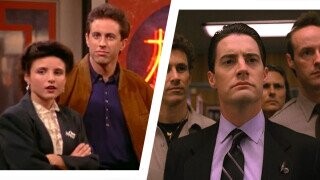Why ‘Seinfeld’ and ‘Twin Peaks’ Go Together So Well

In the 1990s, television as we know it was reshaped by a darkly surreal, genre-defying show whose characters included idiosyncratic government employees, a little person who hangs out with a giant and a blonde who dies under strange circumstances. We’re talking, of course, about Seinfeld.
The above clip is from Sein Peaks, a Twitter account that creates surprisingly plausible mashups combining Twin Peaks and Seinfeld — or, occasionally, It’s Always Sunny in Philadelphia.
While Sein Peaks is the account that brought this concept to our attention, and, more importantly, the attention of Twin Peaks star Kyle MacLachlan, who remarked, “Those are great mashups,” a quick YouTube search reveals that this is not a new idea. For starters, there’s this three-part series following the same basic concept; the most striking thing about it is that, even though George’s in-laws are played by Twin Peaks actors, it’s his parents who come off like authentic David Lynch characters. And here’s the opposite: Twin Peaks scenes with Seinfeld laugh tracks and audio cues.
There’s more, too: a Seinfeld “revival” in the style of Twin Peaks: The Return; a Twin Peaks-inspired re-edit of the episode where Kramer is a serial murder suspect; Seinfeld’s theme with Twin Peak’s dreamy instruments, Twin Peak’s theme with Seinfeld’s sexy bass, and so on.
What is it that makes a sitcom about a stand-up comedian gel so well with a supernatural soap opera whose storyline transcends time, space and dimensions (“a show about everything,” you could say)? It’s not just that they share a few actors, some hairdos and a certain aesthetic simply by virtue of being recorded around the same time. If that were the case, then you could just as easily mash up Twin Peaks with, say, Beverly Hills 90210 or Full House, but you just can’t (which hasn’t stopped people from trying).
As different as these shows might be on the surface, they share a certain tone and underlying philosophy. Both Larry David and David Lynch have spent their entire careers seeking the absurdity in the mundane and heightening it. It’s not a coincidence that both like using run-of-the-mill diners as recurrent settings in their work or that some of the most famous moments in both series revolve around the sort of idle talk that would be nothing but filler in lesser shows.
Each is populated by utterly ridiculous characters that somehow still ring true — from a lady who never stops cradling a log to another one who can only be made to part with marble rye via physical violence. The main difference is that Seinfeld’s observations about the surreal side of everyday life make you say, "Haha, oh, that Kramer!" while Lynch’s leave you staring at the empty screen for 15 minutes after the episode is over, questioning the nature of reality (and craving pie).
Anyway, be sure to check out Sein Peaks’ Lynch-inspired Seinfeld podcast serial. It’s *insert “damn fine” or “gold, Jerry” here, depending on your preference*.
Follow Maxwell Yezpitelok's heroic effort to read and comment on every '90s Superman comic at Superman86to99.tumblr.com.
Thumbnail: Columbia Pictures Television, CBS Television Distribution